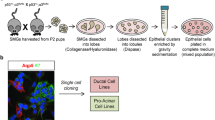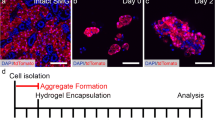Summary
Apoptosis is a highly organized cellular process that is critical for maintaining glandular homeostasis. We have used primary rat salivary acinar cells from the parotid and submandibular glands to investigate the critical regulatory events involved in apoptosis. Caspase-3 activity, cleavage of caspase substrates, and deoxyribonucleic acid (DNA) fragmentation were assayed in cells treated with etoposide, a DNA-damaging agent, or brefeldin A (BFA), a Golgi toxin. Dose-response studies showed that the sensitivity of both cell types to etoposide and BFA was similar, with 150 μM etoposide or 1.5 μM BFA inducing maximal caspace activation. However, BFA induced a more robust activation of caspase and DNA fragmentation in both cell types. Similar results were observed when the caspase cleavage of poly(adenosine 5′-diphosphate ribose) polymerase and protein kinase C delta were analyzed by Western blot. Analysis of the kinetics of apoptosis showed that caspace-3 activation was maximal at 8 h of etoposide or BFA treatment in the parotid cells and at 8–18 h in the submandibular cells. A similar time course was observed when DNA fragmentation was assayed, although maximal DNA fragmentation in BFA-treated cells was two-to threefold higher than that observed in etoposide-treated cells. Despite slight kinetic differences, it would appear that the apoptotic cascade is very similar in both primary parotid and submandibular acinar cells. Although limited in their long-term stability in culture, the use of primary, nonimmortalized salivary acinar cultures will also permit the use of specific transgenic animals to further characterize the molecular events involved in the regulation of salivary gland acinar cell apoptosis.
Similar content being viewed by others
References
Allen, R. T.; Cluck, M. W.; Agrawald D. K. Mechanisms controlling cellular suicide: role of Bcl-2 and caspases. Cell. Mol. Life Sci. 54:427–445; 1998.
Anderson, S. M.; Reyland, M. E.; Hunter, S.; Deisher, L. M.; Barzen, K. A.; Quissell, D. O. Etoposide-induced activation of c-jun N-terminal kinase (JNK) correlates with drug-induced apoptosis in salivary gland acinar cells. Cell Death Differ. 6:454–462; 1999.
Atkinson, J. C.; Travis, W. D.; Pillemer, S. R.; Bermudez, D.; Wolff, A.; Fox, P. C. Major salivary gland function in primary Sjögren’s syndrome and its relationship to clinical features. J. Rheumatol. 17:318–322; 1990.
Cohen, G. M. Caspases: the executioners of apoptosis. Biochem. J. 326:1–16; 1997.
Decker, P.; Muller, S. Modulating poly (ADP-ribose) polymerase activity: potential for the prevention and therapy of pathogenic situations involving DNA damage and oxidative stress. Curr. Pharm Biotechnol. 3:275–283; 2002.
Denning, M. F.; Wang, Y. H.; Nickoloff, B. J.; Wrone-Smith, T. Protein kinase C delta is activated by caspase-dependent proteolysis during ultraviolet radiation-induced apoptosis in human keratinocytes. J. Biol. Chem. 273:29995–30002; 1998.
DeVries, T. A.; Neville, M. C.; Reyland, M. E. Nuclear import of PKC delta is required for apoptosis: identification of a novel nuclear import sequence. EMBO J. 21:6050–6060; 2002.
Ek, B.; Antonsson, B.-M. Studies of muscarinic receptor reserve linked to phosphoinositide hydrolysis in parotid gland and cerebral cortex. Acta Physiol. Scand. 147:289–295; 1993.
Enari, M.; Sakahira, H.; Yokoyama, H.; Okawa, K.; Iwamatsu, A.; Nagata, S. A caspase-activated DNase that degrades DNA during apoptosis, and its inhibitor ICAD. Nature 391:43–50; 1998.
Fox, P. C. Saliva composition and its importance in dental health. Compend. Contin. Educ. Dent. Suppl. 13:S457-S460; 1989.
Green, D. R. Apoptotic pathways: paper wraps stone blunts scissors. Cell 102:1–4; 2000.
Green, D. R.; Evan, G. I. A matter of life and death. Cancer Cell. 1:19–30; 2002.
Guo, H.; Tittle, T. V.; Allen, H.; Maziarz, R. T. Brefeldin A-mediated apoptosis requires the activation of caspases and is inhibited by Bcl-2. Exp. Cell Res. 245:57–68; 1998.
Hendricks, L. C.; McClanahan, S. L.; Palade, G. E.; Farquhar, M. G. Brefeldin A affects early events but does not affect late events along the exocytic pathway in pancreatic acinar cells. Proc. Natl. Acad. Sci. USA 89:7242–7246; 1992.
Hengartner, M. O. The biochemistry of apoptosis. Nature 407:770–776; 2000.
Hofmann, K. The modular nature of apoptotic signaling proteins. Cell. Mol. Life Sci. 55:1113–1128; 1999.
Limesand, K. H.; Barzen, K. A.; Quissell, D. O.; Anderson, S. A. Synergistic suppression of apoptosis in salivary acinar cells by IGF1 and EGF. Cell Death Differ. 10:345–355; 2003.
Mandel, I. D. The functions of saliva. J. Dent. Res. 66:623–627; 1987a.
Mandel, I. D. Impact of saliva on dental caries. Compend. Contin. Educ. Dent. Suppl. 13:S476-S481; 1987b.
Mandel, I. D. The role of saliva in maintaining oral homeostasis. J. Am. Dent. Assoc. 119:298–304; 1989.
Matassa, A. A.; Carpenter, L.; Biden, T. J.; Humphries, M. J.; Reyland, M. E. PKC delta is required for mitochondrial-dependent apoptosis in salivary epithelial cells. J. Biol. Chem. 276:29719–29728; 2001.
Nakamura, S.; Ikebe-Hiroki, A.; Shinohara, M.; Ohyama, Y.; Mouri, T.; Sasaki, M.; Shirasuna, K.; Nomoto, K. An association between salivary gland disease and serological abnormalities in Sjogren’s syndrome. J. Oral Pathol. Med. 26:426–430; 1997.
Nicholson, D. W.; Thornberry, N. A. Caspases: killer proteases. Trends Biochem. Sci. 22:299–306; 1997.
Pilihronis, M.; Tapinos, N. I.; Theocharis, S. E.; Economou, A.; Kittas, C.; Moutsopoulos, H. M. Modes of epithelial cell death and repair in Sjögren’s syndrome (SS). Clin. Exp. Immunol. 114:485–490; 1998.
Quissell, D. O.; Barzen, K. A.; Redman, R. S.; Camden, J. M.; Turner, J. T. Development and characterization of SV40 immortalized rat parotid acinar cell lines. In Vitro Cell. Dev. Biol. 34:58–67; 1998.
Quissell, D. O.; Redman, R. S.; Mark, M. R. Short-term primary culture of acinar-intercalated duct complexes from rat submandibular glands. In Vitro Cell. Dev. Biol. 22:469–480; 1986.
Redman, R. S.; Quissell, D. O.; Barzen, K. A. Effects of dexamethasone, epidermal growth factor, and retinoic acid on rat submandibular acinar-intercalated duct complexes in primary culture. In Vitro Cell. Dev. Biol. 24:734–742; 1988.
Redman, R. S.; Quissell, D. O.; Barzen, K. A. Effects of oxygen, insulin, and glucagon concentrations on rat submandibular acini in serum-free primary culture. In Vitro Cell. Dev. Biol. 30:833–842; 1994.
Reyland, M. E.; Anderson, S. M.; Matassa, A. A.; Barzen, K. A.; Quissell, D. O. Protein kinase C delta is essential for etoposide-induced apoptosis in salivary gland acinar cells. J. Biol. Chem. 274:19115–19123; 1999.
Reyland, M. E.; Barzen, K. A.; Anderson, S. M.; Quissell, D. O.; Matassa, A. A. Activation of PKC is sufficient to induced an apoptotic program in salivary gland acinar cells. Cell Death Differ. 7:1200–1209; 2000.
Rich, T.; Allen, R. L.; Wyllie, A. H. Defying death after DNA damage. Nature 407:777–783; 2000.
Sakahira, H.; Enari, M.; Nagata, S. Cleavage of CAD inhibitor in CAD activation and DNA degradation during apoptosis. Nature 391:96–99; 1998.
Salvesen, G. S. Programmed cell death and the caspases. APMIS 107:73–79; 1999.
Tabak, L. A.; Bowen, W. H. Roles of saliva (pellicle), diet, and nutrition of plaque formation. J. Dent. Res. 68:1560–1566; 1989.
Tamaki, H.; Yamashina, S. Structural integrity of the Golgi stack is essential for normal secretory function of rat parotid acinar cells: effects of brefeldin A and okadaic acid. J. Histochem. Cytochem. 50:1611–1623; 2002.
Thornberry, N. A. Caspases: key mediators of apoptosis. Chem. Biol. 5:R97-R103; 1998.
Thornberry, N. A.; Lazabnik, Y. Caspases: enemies within. Science 281:1312–1316; 1998.
Van Maanen, J. M.; Retel, J.; de Vries, J.; Pinedo, H. M. Mechanism of action of antitumor drug etoposide: a review. J. Natl. Cancer Inst. 80:1526–1533; 1988.
Widmann, C.; Gibson, S.; Johnson, G. L. Caspase-dependent cleavage of signaling proteins during apoptosis. A turn-off mechanism for anti-apoptotic signals. J. Biol. Chem. 273:7141–7147; 1998.
Zimmermann, K. C.; Green, D. R. How cells die: apoptosis pathways. J. Allergy Clin. Immunol. 108:S99-S103; 2001.
Author information
Authors and Affiliations
Corresponding author
Rights and permissions
About this article
Cite this article
Limesand, K.H., Barzen, K.A., Sanders, L.A. et al. Characterization of rat parotid and submandibular acinar cell apoptosis in primary culture. In Vitro Cell.Dev.Biol.-Animal 39, 170–177 (2003). https://doi.org/10.1007/s11626-003-0012-1
Received:
Accepted:
Issue Date:
DOI: https://doi.org/10.1007/s11626-003-0012-1




